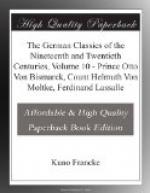The Byzantine element in the Russian architecture is then historically easy to explain. The Moresque originated with the necessity of decorating the individual parts, and relates only to these.
The railings of the Ikonostase are interlaced with vines, garlands, and animal forms. The flat walls, principally where they are not gilt, are decorated with leafwork, rosettes, and twining vines. Where this could not be cut in stone it was painted, and the deficiency in drawing was supplied by a variety of the most glaring colors. Of course, they remained far behind the tasteful, artistic arabesques of the Alhambra and the Alcazar.
The craziest thing in the way of architecture is the Church of Ivan Blajennoj, on the Red Square before the Kremlin. It cannot be described. This building stands on uneven ground, although the fine level Place is before it. It crouches on the edge of the hill, and leaves one leg hanging down. There is no trace of any symmetry. It has no central point, and no one part is like another. One cupola looks like an onion, another like a pineapple, an artichoke, a melon, or a Turkish turban. It contains nine different churches, each having its own altar, Ikonostase, and sanctuary. You enter several of these on the ground floor. To reach others, you ascend a few steps. Between these is a labyrinth of passages so narrow that two people can with difficulty pass each other. Of course, all these churches are very narrow. The one in the main tower can scarcely contain more than twenty or thirty persons, and yet its vaulted roof reaches into the tower at a height of over a hundred feet. This church is painted with all the colors of the rainbow, inside and out, and plated with silver and gold. The cupolas shine with red, green, and blue glazed bricks, and even the masonry has been colored by the artist.
This monstrosity emanated from the brain of Ivan Hrosnoj, “the Terrible John.” When he saw the architect’s work complete he was delighted, loaded him with praise, embraced him, and then ordered his eyes to be put out, that no such second masterpiece should be attributed to him.
But, with all its singularity, this church does not produce a disagreeable impression. It cannot be denied that it is at least original.
Everything, on the contrary, left from the old Dworez (palace) is really beautiful. There is a strange four-story building narrowing toward the top. There is a balcony formed by each receding story, from which there is a fine view. The second story contains, besides the rich but small chapel, a banquet-hall, like the Kanter’s,[40] in Marienburg, only that there the entire vaulted roof is borne by a slender column, and here by a thick pillar. The entrance is in one corner; the throne stands diagonally opposite in the other. At present, the walls are covered with splendid tapestries, and the great throne draped with drap d’or, lined with real ermine. This drapery cost forty thousand rubles. The small but exquisite rooms in the third story are charming. The fourth story is only one large room. It was the Terima, or dwelling of the women—the room in which Peter I. grew up.




